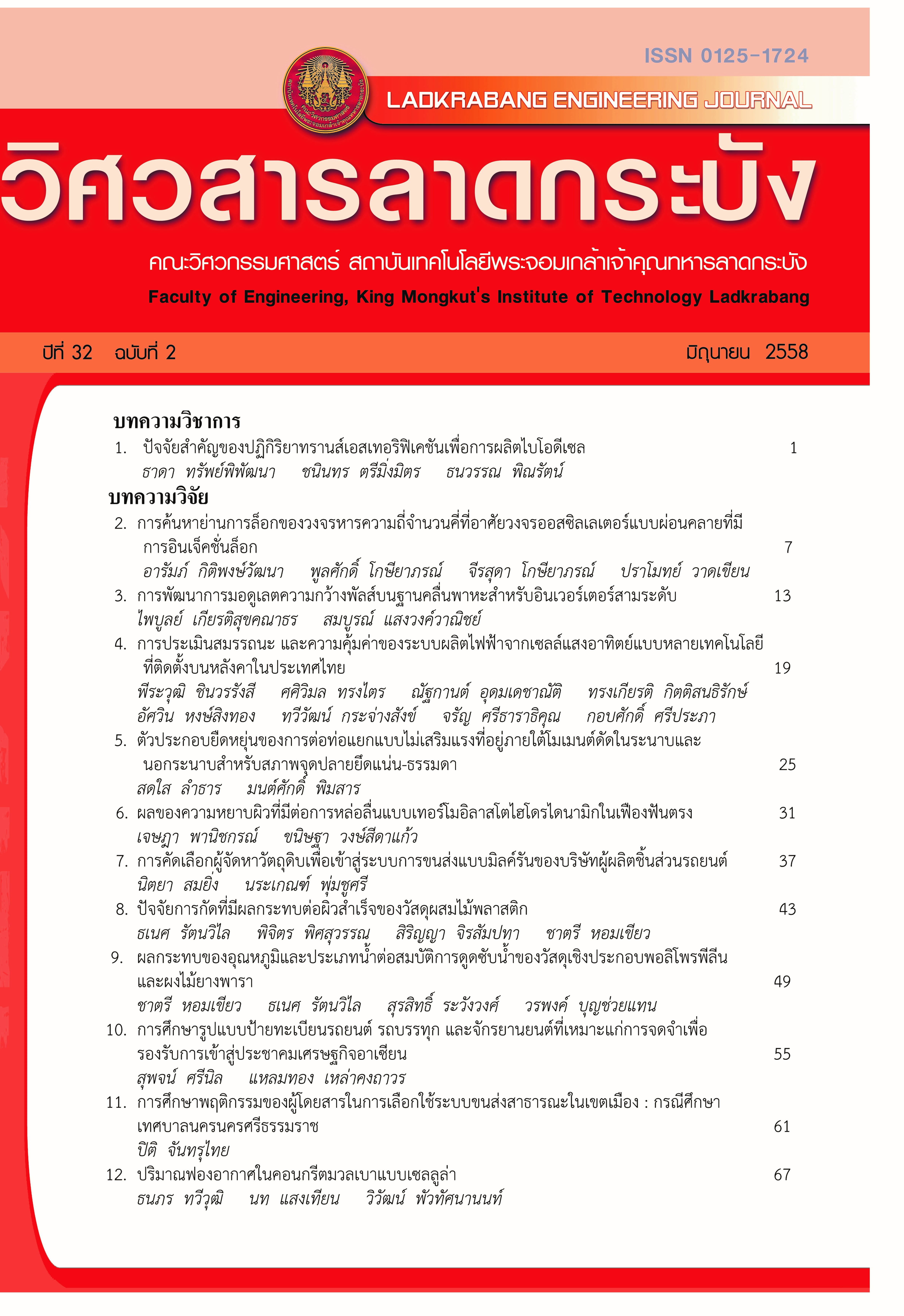Effect of Temperatures and Water Types on Water Absorption of Rubberwood Flour-Polypropylene Composites
Keywords:
Wood-plastic composites,, rubberwood flour,, water absorption,, temperatureAbstract
This article presents an effect of temperatures and water types on water absorption of recycled polypropylene (rPP) composites reinforced with rubberwood flour (RWF). The composite materials were produced into sample panels by using a twin-screw extruder. According to the test results, water absorption (WA) of the composites increased with RWF content and immersion time. The WA content is highest about 3.91%. An increase of the water temperature levels from 25 to 65 oC significantly increased the WA of the composites. The composites soaked in Thailand Gulf water had smaller water absorption than in tap water. Likewise, reduction in flexural strength and modulus of the composites after immersing in Thailand Gulf water is lower than in tap water, decreasing 21.9% and 37.9%, respectively.
References
[2] C. Clemons, "Wood-Plastic Composites in the United States," Forest Products Journal, Vol. 52, pp. 10-18, 2002.
[3] Y. Xie, C.A.S. Hill, Z. Xiao, H. Militz, "Silane Coupling Agents Used for Natural Fiber/Polymer Composites: A Review," Composites: Part A, Vol. 41, pp. 806-819, 2010.
[4] C. Homkhiew, T. Ratanawilai, W. Thongruang, "Composites from Recycled Polypropylene and Rubberwood Flour: Effects of Composition on Mechanical Properties," Journal of Thermoplastic Composite Materials, Vol. 28, pp. 179-194, 2015.
[5] S. Rimdusit, W. Smittakorn, S. Jittarom, S. Tiptipakorn, "Highly Filled Polypropylene Rubber Wood Flour Composites," Engineering Journal, Vol. 15, pp. 17-30, 2011.
[6] D.D. Stokke, D.J. Gardner, "Fundamental Aspects of Wood as a Component of Thermoplastic Composites," Journal of Vinyl and Additive Technology, Vol. 9, pp. 96-104, 2003.
[7] T. Ratanawilai, P. Lekanukit, S. Urapantamas, "Effect of Rubberwood and Palm Oil Content on the Properties of Wood-Polyvinyl Chloride Composites," Journal of Thermoplastic Compos Mater, Vol. 27, pp. 719-730, 2014.
[8] K.B. Adhikary, S. Pang, M.P. Staiger, "Long-Term Moisture Absorption and Thickness Swelling Behaviour of Recycled Thermoplastics Reinforced with Pinus Radiata," Chemical Engineering Journal, Vol. 142, pp. 190-198, 2008.
[9] C. Homkhiew, T. Ratanawilai, "Optimal Proportions of Composites from Polypropylene and Rubberwood Flour after Water Immersion Using Experimental Design," KKU Research Journal, Vol. 19, pp. 780-793, 2014.
[10] S.K. Najafi, H.Y. Kordkheili, "Effect of Sea Water on Water Absorption and Flexural Properties of Wood-Polypropylene Composites," European Journal of Wood and Wood Products, Vol. 69, pp. 553-556, 2011.
[11] T.T. Law, Z.A.M. Ishak, "Water Absorption and Dimensional Stability of Short Kenaf Fiber-Filled Polypropylene Composites Treated with Maleated Polypropylene," Journal of Applied Polymer Science, Vol. 120, pp. 563-572, 2011.
[12] S. Tamrakar, R.A. Lopez-Anido, "Water Absorption of Wood Polypropylene Composite Sheet Piles and its Influence on Mechanical Properties," Construction and Building Materials, Vol. 25, pp. 3977-3988, 2011.
[13] C. Homkhiew, T. Ratanawilai, W. Thongruang, "Long-Term Water Absorption and Dimensional Stability of Composites from Recycled Polypropylene and Rubberwood Flour," Journal of Thermoplastic Composite Materials, DOI: 10.1177/0892705713518789.
Downloads
Published
How to Cite
Issue
Section
License
The published articles are copyrighted by the School of Engineering, King Mongkut's Institute of Technology Ladkrabang.
The statements contained in each article in this academic journal are the personal opinions of each author and are not related to King Mongkut's Institute of Technology Ladkrabang and other faculty members in the institute.
Responsibility for all elements of each article belongs to each author; If there are any mistakes, each author is solely responsible for his own articles.






